Wrist pain and discomfort during strength training is not uncommon. Fortunately though, you don’t have to drop your gym membership to stop the pain. Read on to see if you fall into any of the most common risk categories and what you need to know to keep your wrists healthy while still getting a great workout.
Risk Factors
The most common risk factors for wrist pain are overuse, poor mechanics in daily or sporting habits, lack of mobility & flexibility, and medical conditions such as carpal tunnel or inflammation. Most people do not realize how much stress the wrists endure and just how important it is to maintain flexibility in the muscles that control its flexion, extension, pronation, and supination.¹ We stir up recipes, carry groceries or little people, maintain our homes and yards, and type on our computers all day long. Certain jobs like hair stylists, mechanics, and surgeons that require fine motor control of the hands are especially vulnerable to developing chronic wrist issues. Athletes in sports such as baseball or tennis, and even new moms, can also be vulnerable to developing wrist pain from constantly using the wrists at odd angles and intensities.
The bottom line on wrist pain is that it can affect a variety of people of all ages and backgrounds. The common link is typically either overuse, loss of mobility, or a failure to use proper form in sports, computer work, or occupational tasks.
When people are predisposed to experiencing wrist pain in daily life, coming to the gym and doing exercises such as pushups or planks can lead to a flare up. Because the pain occurs at the gym, they immediately blame it on the exercise, instead of looking at the underlying causes. Exercises like pushups and planks become scapegoats and people give up on these great multi-purpose moves as a result.
Change the Angle
Anything that places your wrists in full extension (hand bent backwards) or loads a weight or your body onto those fully extended wrists can create stress or pain. The solution is actually quite simple. Take out or lessen the angle. Keep your wrist as neutral as possible.¹ For some clients I’ve worked with, this simple concept can decrease their wrist discomfort in the gym instantly. Check out this quick video to see a few practical ideas for applying this concept:
https://www.youtube.com/watch?v=41jS7TkRB_I
Join the Mod Squad
There are so many modifications for every exercise! You have 2 main categories of modification options. You can either modify the angle of your hands but do the same exercise. OR you can substitute a different exercise to work the same muscles.
Modifying Angle of the Wrist
Let’s start with the first option, changing the angle of the hands. Instead of putting all your body weight onto your hands, with wrists in full extension, like the pic on the right, you can use handles or dumbbells to maintain neutral wrists, like the pic on the left. You can apply this principle to many other exercises as well, a few examples of which are detailed below and demonstrated in the video above:
Pushups – use handles/TRX / dumbbells/folded yoga mat
Planks – go to elbows / dumbbells / handles/ hold onto side of bench with neutral wrists
Mountain Climbers – hold side of bench or dumbbells / handles
Front Squats – use crossover hands or hold kettlebell instead of barbell ²
Modifying with a Different Exercise
Now let’s explore the second option, substituting. Start by thinking about which muscles you are trying to target with a particular movement. For example, a pushup targets the chest, shoulders, triceps, and core. Simply pick a different exercise that targets those same muscles but in a way that doesn’t bend the wrists. Some great substitutes for pushups are dumbbell bench press or fly, standing cable fly, or stability ball chest press or fly. A 2006 research study on wrist pain during strength training also suggests using resistance bands to help maintain neutral wrists for basic strength training moves.


Maintain Mobility and Flexibility
An ounce of wrist pain prevention is worth a pound of cure. The last aspect we’ll cover here is the importance of maintaining mobility and flexibility with a few simple, proactive measures. If you have wrists that aren’t properly flexible due to tight forearm muscles or other reasons, you’re going to experience discomfort when you go to the gym and try to force that joint to extend farther than its tight muscles want it to go. One solution is to try to set up your working environment to allow your wrist to be as neutral as possible during your non-gym activities. This approach applies to virtually any activity but especially important for computer work. Using ergonomic keyboards and mousepads is great for long term prevention. You can also incorporate regular wrist and forearm stretches and rotations into your workout routine. Using a small dense ball to massage your forearms can also help complement regular static stretching.
Conclusion
As you can see, modifying or substituting your exercises to lessen the impact on your wrists is actually simple, you just need to know your risk factors and how to adjust. Listening to your body is the most important lesson you can take away from this discussion. You should never push through pain, especially in such an important joint as the wrist. Instead, learn from the pain and find a work around. Being aware of your risk factors is helpful as well because it gives you another perspective instead of simply giving up on strength training. So keep training hard, but remember, no pain is a big gain when it comes to your wrists!
References
1. Sinclair, A. & Pujol, T. Adapting upper-body resistance training exercises for clients with carpal tunnel syndrome. Strength and Conditioning Journal 28.6(Dec 2006): 30-36.
2. Waller, M. & Townsend, R. The front squat and its variations. Strength and Conditioning Journal 29.6 (Dec 2007): 14-19.
Word of Caution
You should always speak to your doctor before you stop, start, or change your exercise routine, especially if you are currently experiencing pain. Reading fitness information online can be helpful, but it cannot replace the professional diagnose and treatment you might need from a qualified healthcare provider.




